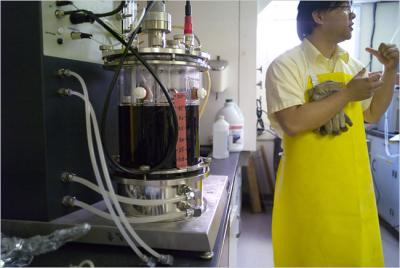Biofuel can be pretty interesting stuff, when made from the proper feed stock. But there is a problem. When you are done you have some left overs, in the case of biodiesel you have glycerin, with ethanol you have a mash of plant matter left over. These products do have useful properties. Glycerin for instance is used in soap, makeup, and a whole host of other products, but as the biodiesel market has heated up the glycerin market has become saturated. That is why Ronald Holser a research chemist, and his colleague Steven F. Vaughn, a plant physiologist are trying to figure out new ways to use these byproducts. “Just like petroleum refineries make more than one product that are the feedstock for other industries, the same will have to be true for biofuels,†said Kenneth F. Reardon, a professor of chemical and biological engineering at Colorado State University in Fort Collins. “Biorefining is what the vision has to look like in the end.â€
So what are they making? So far they have cooked up ways to create sticky mats that hold grass seed until it grows, and a way to control weeds, but are working on other products. Another company PureVision is working on ways to use the leftovers from Ethanol production. The leftovers, called lignin are the hard fibrous parts of the plant, most places simply burn it as a fuel input in the distillation process. At $40 a tonne, this is not a very good way to make money from your waste product. PureVision has figured out a way to create a resin like substance that can be used in glues, and sealants, worth $300 a tonne.
People are working on producing higher quality glycerin, safer and more effective catalysts to use in the biofuel process, even to create hydrogen from leftover corn ethanol mash. Various groups are trying to make everything from furniture glue, to hospital gowns, to anti-freeze, to more biofuel.
While biofuels made from food sources still have the problem of taking food away from people to feed cars, if the biofuels are created using sustainable input materials along with these new byproducts they may provide a way to fuel the few vehicles that we can not turn into electric only vehicles.

A really good book on this topic that dispels a lot of myths about biodiesel, while also providing detailed recommendations on building a small-scale plant, is Biodiesel: Basics and Beyond, by William Kemp. The by-products should not be underestimated. The glycerin from home-scale processes typically has impurities that render it toxic and not usable for soap and other traditional glycerin uses. This can be impacted by a well controlled and designed process as described in this book. Ironically, a lot of home-scale biodiesel producers, without the proper chemical and engineering backgrounds, are using less than first-rate processes and probably creating far more damage to the environment than they are preventing.
One solution might be the use of straight vegetable oil (SVO) instead of biodiesel. Disadvantages: (1) It would require vehicle modification unlike biodiesel in standard diesel cars. (2) It would become unusable in cold weather (this might be modifiable through additives or the addition of a pre-heater to the engine). Advantages: (1) removes the whole transesterification step (the chemical process used to turn SVO into biodiesel) and thus avoids the glycerin byproduct.